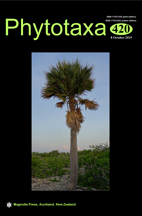Abstract
Mexico has a rich woody bamboo flora with over 52 species, 66% of which are endemic. Mexico represents the northernmost extent for many Neotropical bamboo genera such as the widespread Rhipidocladum, a genus with characteristic fan-like branching and variable synflorescence morphologies. Only four species of Rhipidocladum are known from Mexico: R. bartlettii, R. martinezii, R. pittieri and R. racemiflorum. Remarkably, the ranges of all four species overlap in the Mexican state of Chiapas. During field work in Chiapas, a flowering population of Rhipidocladum was discovered that had two glumes and retrorsely scabrous abaxial leaf surfaces, and lacked foliage leaf fimbriae. This combination of characters is unlike that of any known species in the genus. We conducted a comprehensive morphological study of specimens from this population and confirmed the existence of a new species of Rhipidocladum. We describe and illustrate the new taxon, discuss its diagnostic characters and provide an updated key to the species of Rhipidocladum distributed in Mexico. This taxonomic novelty increases the richness of the genus to 20 species and adds a new endemic woody bamboo to the flora of Mexico. The new species inhabits montane cloud forest, an important yet threatened vegetation type in Mexico.

